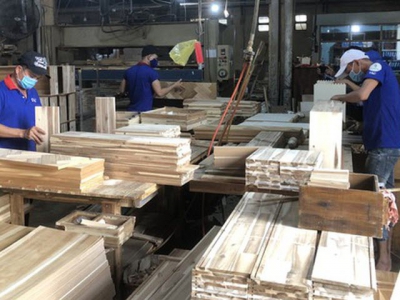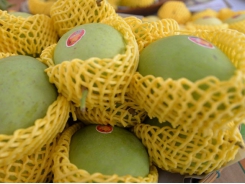Opportunities to develop agricultural materials domestically

In the past months, the high prices of imported agricultural materials have made the market prices of agricultural products escalate. Many products even have had to cover losses. According to experts, this is also an opportunity to develop the source of raw materials in Vietnam to meet the needs of domestic production.
Rubberwood production at Thuan An Wood Processing Joint Stock Company in Binh Duong Province. (Photo: SGGP)
Imported products increased
According to the Vietnam Timber and Forest Product Association (VIFOREST), the prices of imported wood have increased by 20-25 percent; The prices of auxiliary materials, such as glue, paint, and paper, have also inched up by 10-20 percent compared to last year. This has made the cost prices of products go up, causing difficulties for manufacturing enterprises.
Ms. Le Thi Xuyen, CEO of Thuan An Wood Processing Joint Stock Company in Binh Duong Province, said that every time the price increases, the company must continuously adjust the prices following the production costs. Most of the raw materials for the production of wooden products must be imported from abroad. Due to the Covid-19 pandemic, many countries, such as the US and Europe, had to carry out social distancing and temporarily suspend exploitation, production, and processing.
As a result, the source of raw materials has gradually been exhausted. However, the demand for wooden products has increased, while the logistics costs have also climbed. On the other hand, foreign orders usually require that the surface material of products must be pine and oak wood, and the inside is mainly acacia wood and rubberwood of Vietnam.
Not only the wood industry, but many imported agricultural materials have also seen price hikes, such as fertilizers and animal feed. The representative of a livestock company in Dong Nai Province shared that after the Lunar New Year, the price of chicken feed increased by more than VND2,000 per kilogram, so the cost price is currently at VND11,000 per kilogram, while the selling price of chicken is about VND20,000 per kilogram. Veterinary products have also risen.
Last year, because domestic chicken prices fell, the company was unable to compete with imported chickens, so it had to reduce the chicken flock by more than 40 percent. Instead, it has raised pigs to cover the loss. If the situation remains pessimistic, the company will cut another 20 percent of the total flock to maintain operations. According to Tien Phong Pig Farming Cooperative in HCMC, in the past six months, the price of animal feed had increased five times, with a total increase of more than 20 percent because animal feed was mainly imported.
Similarly, in the first three months of this year, fertilizer prices increased heavily and a local shortage occurred. Fertilizer prices increased due to many reasons but were mainly affected by input costs. In comparison with the end of last year, the prices of export and domestic DAP fertilizers have soared drastically. Compared to DAP fertilizers, urea fertilizer went up more slowly, due to the active restraint of manufacturers.
It is recorded that at the beginning of March this year, at agents of Ca Mau fertilizer in the South, urea fertilizer is being offered by the factory for VND8,500 per kilogram, lower than that in the region and the world, but has increased by about 20 percent compared to the end of last year.
Opportunity to build Vietnamese brands
According to Ca Mau Fertilizer Company, to contribute to stabilizing the fertilizer market, in the summer-autumn crop this year, the company plans to supply 190,000-230,000 tons of fertilizer to the market, meeting the needs of farmers in Southern provinces.
Besides the efforts of the production department, the company has proactively rescheduled the delivery of export orders to other countries to prioritize the distribution of fertilizers in the domestic market. In addition, the company has researched to improve and launch new product lines to help plants to grow well, save costs, increase profits, and increase productivity.
According to Mr. Le Quoc Phong, Vice Chairman of the Vietnam Fertilizer Association, the prices of imported fertilizers increased because the raw material-producing countries had temporarily carried out social distancing due to the Covid-19 pandemic. Many agricultural countries have resumed production and increased the import of fertilizers. On the other hand, for having to comply with signed contracts, many domestic fertilizer companies must export fertilizers, causing a shortage of fertilizers for domestic consumption.
Therefore, the Ministry of Agriculture and Rural Development needs to participate in managing and forecasting the needed fertilizer output of the whole country. The Ministry of Industry and Trade should have a plan for importing and consuming fertilizers nationwide, aiming to regulate the market.
Mr. Nguyen Thanh Son, Chairman of the Vietnam Poultry Association, said that the lack of animal feed was because some foreign enterprises had collected, hoarded, and reserved raw materials for the production of animal feed, so the hike in prices of animal feed was unavoidable. From now until the end of the year, animal feed prices would continue to escalate.
Therefore, enterprises need to adjust the selling prices and production scale accordingly. In the context that the domestic livestock industry is developing, the State needs to make a plan to develop raw material growing areas for the production of animal feed. For instance, it is possible to develop models of growing corn or producing animal feed from by-products in seafood processing.
According to the Handicraft and Wood Industry Association of Ho Chi Minh City, at present, foreign orders are mainly processing under signed contracts, many countries only require the production of wood types in the orders. Obviously, this is a good opportunity for Vietnam's wood manufacturing industry to thrive. Currently, Vietnam's acacia wood and rubberwood are of good quality with plentiful supply, that can replace pine and oak wood. Moreover, Vietnamese wood is cheaper and has much lower transportation costs. Therefore, enterprises need to coordinate with the State to promote advertising and introducing models of wooden products made of Vietnamese wood to importing countries, heading to expand consumption markets.
Related news
Tools

Phối trộn thức ăn chăn nuôi

Pha dung dịch thủy canh

Định mức cho tôm ăn

Phối trộn phân bón NPK

Xác định tỷ lệ tôm sống

Chuyển đổi đơn vị phân bón

Xác định công suất sục khí

Chuyển đổi đơn vị tôm

Tính diện tích nhà kính

Tính thể tích ao



 Mekong Delta farmers put effort into elevating Vietnamese…
Mekong Delta farmers put effort into elevating Vietnamese…  Global market share of Vietnamese mangoes remains modest
Global market share of Vietnamese mangoes remains modest